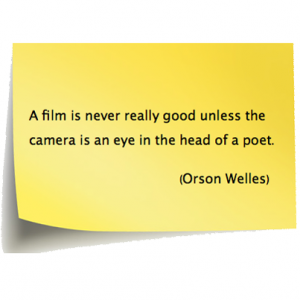Montage techniques
A montage sequence is usually used in combination with music. For the duration of the music insert a series of mainly dialogue-free atmospheric bit-scenes are strung together. It may also be used for time compression / summary of events, as scene transition or to make clear that a certain action is repeated several times.
When a montage sequence encompasses several locations then these are listed in the scene heading separated by a slash (/). Should the montage sequence stretch over several day times then time details are summarized as DAY/NIGHT or just left out. An example of a scene heading: EXTERNAL. AIRPORT / HOTEL / TAXI – DAY/NIGHT (MONTAGE SEQUENCE)
Unlike a montage sequence with a narrative character a montage is just a short impressionist mood or location description. The single settings are listed separated by dashes as their order is not chronologically set. An example of a secondary heading: MONTAGE – BERLIN
The crossing / intertwining of two or more storylines is a dramatic composition tool that can be realized through the help of parallel montage. The alternating storylines happen simultaneously, but they may also take place on different time levels, so that parallel montage can create an impression of concurrency.
- When parallel montage switches between entire scenes the scene transition is announced by a CROSS CUT WITH and is followed by a new scene.
- When there is a frequent transition between two scenes each scene is cited only the first time. For every other crosscut secondary headings are used in the course of parallel montage.
- A SERIES OF SHOTS are single shots without any dialogue and are numbered with capital letters.
An intercut of a scene is marked in a script whereby it isn’t declared how it is to be executed. A typical example of an intercut-scene is a telephone conversation.
The scene starts with a scene heading listing all locations and possibly encompassing a scene description. A change of scenery is announced by INTERCUT WITH and is followed by the respective secondary heading.
A dream sequence stretches over several scenes. An example for a scene heading: EXTERNAL. WOODS – DAY (DREAM SEQUENCE)
A flashback sequence or flashforward sequence stretches over several scenes.
An example for a scene heading: INTERNAL. TUNNEL – NIGHT (FLASHBACK SEQUENCE)
A simple flash, flashback or flashforward constitutes only a short moment, e.g. a sudden memory fragment. An example for a secondary heading: FLASHBACK – CLUB 82005)
An insert is a detailed close-up of a plot relevant object. Thereby it is enough to list the object in the secondary heading. An example for a secondary heading: PREGNANCY TEST
An on-screen text display is called SUPER(IMPOSE) in script-code.
For example: SUPER: BERLIN, 1989



Comments are closed.